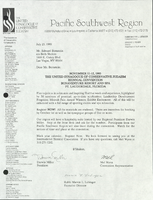Search the Special Collections and Archives Portal
Search Results

Interview with Byron Leo Ristvet, April 17, 2006
Date
2006-04-17
Archival Collection
Description
Narrator affiliation: Containment scientist, Defense Threat Reduction Agency, Dept. of Defense
Text

Interview with Robert W. Taft, August 5, 2004
Date
2004-08-05
Archival Collection
Description
Narrator affiliation: Asst. Manager, Plans, Engineering and Budgets, Dept. of Energy
Text

Interview with Peter Ediger, June 24, 2005
Date
2005-06-24
Archival Collection
Description
Narrator affiliation: Administrator, Pace e Bene Franciscan Nonviolence Center
Text

Interview with Sidney D. Drell, July 20, 2004
Date
2004-07-20
Archival Collection
Description
Narrator affiliation: Physicist, Arms Control; Deputy Director, Stanford Linear Accelerator Center
Text

Interview with Richard Lawrence Garwin, July 21, 2004
Date
2004-07-21
Archival Collection
Description
Narrator affiliation: Physicist, IBM; Consultant, Los Alamos National Laboratory
Text

Interview with Robert Nelson, June 30, 2004
Date
2004-06-30
Archival Collection
Description
Narrator affiliation: Deputy Manager, Department of Energy Nevada Operations Office; Episcopal Priest
Text

Meeting minutes for Consolidated Student Senate University of Nevada, Las Vegas, January 28, 2002
Date
2002-01-28
Archival Collection
Description
Includes meeting agenda and minutes.
Text

Meeting minutes for Consolidated Student Senate, University of Nevada, Las Vegas, September 24, 2001
Date
2001-09-24
Archival Collection
Description
Includes meeting minutes and agenda.
Text

Minutes from Temple Beth Sholom Board of Directors meetings, July 1993 - December 1993
Date
1993
Archival Collection
Description
Meeting minutes include reports from committees of the board, correspondence, and balance sheets.
Text
Pagination
Refine my results
Content Type
Creator or Contributor
Subject
Archival Collection
Digital Project
Resource Type
Year
Material Type
Place
Language
Records Classification

